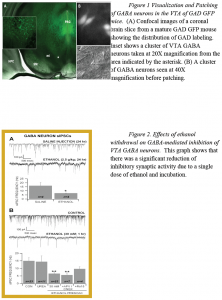Stephanie Sandoval and Dr. Scott Steffesen, Psychology
The mesocortico limbic system is implicated in drug reward. An important substrate underlying chronic effects of ethanol on Dopamine (DA) neurotransmission in the mesolimbic pathway is gamma aminobutyric acid (GABA) neurons in the ventral tegmental area (VTA)(Ludlow et al. 2009). VTA GABAergic interneurons are the primary inhibitory regulator of DA neurons and a subset of GABA(A) receptors may be implicated in the switch from heavy drinking to dependence. Previous studies have shown that chronic ethanol results in a significant down regulation in the expression of D2 receptors in ethanol consuming rats versus the controls. This possibly results from persistent DA release onto GABA neurons (Ludlow et al. 2009).
Chronic exposure to drugs has been shown to increase brain-derived neurotropic factor (BDNF) levels in VTA neurons. It was found that a single injection of BDNF into the VTA promotes a shift from a dopamine-independent to a dopamine-dependent reward system. This shift involves a switch in the GABA(A) receptors of VTA GABAergic neurons, from inhibitory to excitatory signaling (Vargas-Perez, et al. 2009).
Through electrophysiological techniques I were able to better understand the effect of chronic ethanol on VTA GABA neurons and that switch that occurs from a dopamineindependent to a dopamine-dependent reward system.
For this project I used GAD Green florescent Protein (GFP) mice. They were made dependent on ethanol either through injection or by drinking. They were anesthetized and decapitated. We then took slices from their brain that contain VTA region. The GFP GABA neurons were patched on to using an electrophysiological technique called patch clamp. Using the patch clamp method allowed me to measure and take record of the cell’s internal activity.
Our results showed that Low-dose ethanol (5 mM) mildly enhanced, moderate-dose ethanol (i.e., 20 mM) reduced, and high-dose ethanol (i.e., 40 mM) suppressed GAD-67+ VTA GABA neuron firing rate and depolarization-induced spiking. When looking at mice that had previous exposure to ethanol, we found that GABA input to VTA GABA neurons appears to play a role in the neuroadaptations that result from ethanol exposure, even a single exposure. Long-term depression of GABA inhibition to GABA neurons might result in long-lasting potentiation of GABA input to DA neurons. (Wilcox, et al. 2010) The increase in DA input indicates an increase in inhibitory GABA Transmitter. Further research will be done to fully understand how ethanol effects this complex network of cells.

